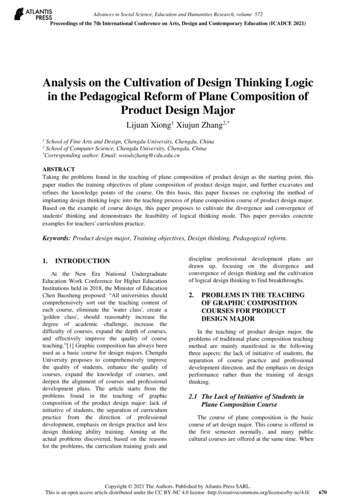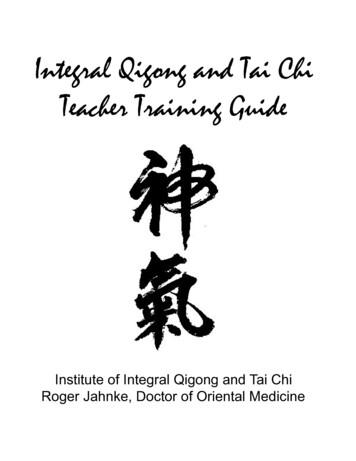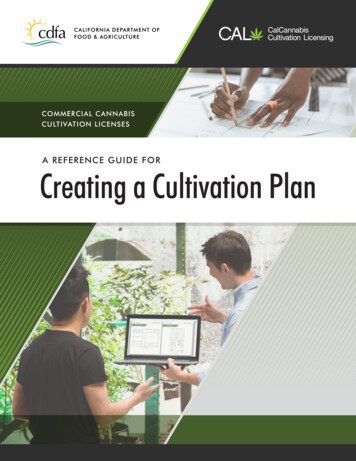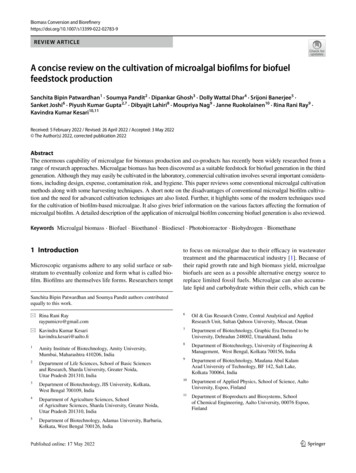
Transcription
Advances in Social Science, Education and Humanities Research, volume 572Proceedings of the 7th International Conference on Arts, Design and Contemporary Education (ICADCE 2021)Analysis on the Cultivation of Design Thinking Logicin the Pedagogical Reform of Plane Composition ofProduct Design MajorLijuan Xiong1 Xiujun Zhang2,*1School of Fine Arts and Design, Chengdu University, Chengdu, ChinaSchool of Computer Science, Chengdu University, Chengdu, China*Corresponding author. Email: woodszhang@cdu.edu.cn2ABSTRACTTaking the problems found in the teaching of plane composition of product design as the starting point, thispaper studies the training objectives of plane composition of product design major, and further excavates andrefines the knowledge points of the course. On this basis, this paper focuses on exploring the method ofimplanting design thinking logic into the teaching process of plane composition course of product design major.Based on the example of course design, this paper proposes to cultivate the divergence and convergence ofstudents' thinking and demonstrates the feasibility of logical thinking mode. This paper provides concreteexamples for teachers' curriculum practice.Keywords: Product design major, Training objectives, Design thinking, Pedagogical reform.1.INTRODUCTIONAt the New Era National UndergraduateEducation Work Conference for Higher EducationInstitutions held in 2018, the Minister of EducationChen Baosheng proposed: “All universities shouldcomprehensively sort out the teaching content ofeach course, eliminate the 'water class', create a'golden class', should reasonably increase thedegree of academic challenge, increase thedifficulty of courses, expand the depth of courses,and effectively improve the quality of courseteaching.”[1] Graphic composition has always beenused as a basic course for design majors. ChengduUniversity proposes to comprehensively improvethe quality of students, enhance the quality ofcourses, expand the knowledge of courses, anddeepen the alignment of courses and professionaldevelopment plans. The article starts from theproblems found in the teaching of graphiccomposition of the product design major: lack ofinitiative of students, the separation of curriculumpractice from the direction of professionaldevelopment, emphasis on design practice and lessdesign thinking ability training. Aiming at theactual problems discovered, based on the reasonsfor the problems, the curriculum training goals anddiscipline professional development plans aredrawn up, focusing on the divergence andconvergence of design thinking and the cultivationof logical design thinking to find breakthroughs.2.PROBLEMS IN THE TEACHINGOF GRAPHIC COMPOSITIONCOURSES FOR PRODUCTDESIGN MAJORIn the teaching of product design major, theproblems of traditional plane composition teachingmethod are mainly manifested in the followingthree aspects: the lack of initiative of students, theseparation of course practice and professionaldevelopment direction, and the emphasis on designperformance rather than the training of designthinking.2.1 The Lack of Initiative of Students inPlane Composition CourseThe course of plane composition is the basiccourse of art design major. This course is offered inthe first semester normally, and many publiccultural courses are offered at the same time. WhenCopyright 2021 The Authors. Published by Atlantis Press SARL.This is an open access article distributed under the CC BY-NC 4.0 license 0
Advances in Social Science, Education and Humanities Research, volume 572students just enter the school, they are faced with astate of unclear professional development, tighttime for schoolwork, and complicated learningcontent. Due to students' unfamiliarity withprofessional courses and the basic nature of coursecontent, it is easy to cause students to "contempt".In addition, teachers did not carry out a goodextension of the course content during the course ofteaching, and they focused on teaching. Studentscould not find the interest of learning from thestudy, and they would easily show that they werenot active in learning. These require teachers toguide students into the state of professional learningand understand the direction of professionaldevelopment during the teaching process.2.2 The Separation of Curriculum Practicefrom the Direction of ProfessionalDevelopmentThe knowledge points of plane compositionmay seem unremarkable, but they are indispensablefor the later professional courses. Traditionalteaching is often just the practice of knowledgepoints and lacks different guidance to thedevelopment direction of design major. In addition,more design thinking and design methods arestudied in the later professional courses, so that thestudents neglect the design application of theconstituent elements and the constituent methods inthe later practice process. As a result, there is notenough interdependence between the depth of the"details" of the design and the theory.2.3 The Emphasis on Design PerformanceRather than the Cultivation of DesignThinking AbilityIn traditional teaching, “composition teachingfocuses on hand skills training, which is quite timeconsuming. In this teaching process, students arebasically limited to the combination of several basicshapes and bones, and focus more on the finedrawing of hands, while ignoring more creativethinking about the form,"[2]. Students practiceexercises, and the requirements for the fineness ofproduction in teaching grading have once becomean important criterion for grading and assessment.This kind of grading method reflects theparticipation of students and the application ofknowledge points to a certain extent, but if it is onlya single knowledge point practice, it lackssystematic and expansive learning of knowledge,let alone the opening of design thinking.The lack of understanding of the curriculumleads to students' lack of initiative, the unclearorientation of the curriculum leads to students' lackof understanding of the systematic knowledge, andthe one-sidedness of the curriculum evaluationstandards leads to students' neglect of thinkingabout innovative design. All these can be attributedto the lack of training intensity in the cultivation ofstudents' design thinking logic.3.THE TRAINING OBJECTIVESAND COMBING THEKNOWLEDGE POINTS OF THECOURSE OF PLANECOMPOSITION OF PRODUCTDESIGN MAJOR3.1 The Training Objectives of PlaneComposition CurriculumThe training goal of plane composition coursemainly includes three aspects: knowledge goal,ability goal and quality goal. The goal ofknowledge is to train students to understand thebasic form of plane composition and its changeform, formation rules and application of formationmethods. Master the basic elements of planecomposition and form of expression, which isconsistent with the direction of product design; Theability objective is to train students to be diligent inthinking and to make full use of the Internet,database and other means in order to devotethemselves seriously to the research. Cultivate thestudents' ability to discover, analyze and solveproblems, and also cultivate the students'innovation consciousness, aesthetic quality andteamwork ability. The quality objectives of studentsmainly include cultivating students' artisticexpression, positive theme thoughts, and goodlanguage expression. Teachers should make it clearthat the course content of plane composition needsto attach importance to the description ofknowledge points and the establishment of designthinking logic at the same time, and make it clearthat the purpose of teaching is not only to describeknowledge itself, but also to establish a systematicknowledge system based on the their storedknowledge, and guide students to think logicallyand divergently in the construction process of thesystem. In order to improve students' ability toanalyze and solve problems and consolidate theexisting knowledge, teachers need to think abouthow to bridge and update the old and newknowledge in the teaching method. The key to671
Advances in Social Science, Education and Humanities Research, volume 572problem solving is to establish a thinking mode ofsystematic analysis of the problem so as to improvethe ability to analyze the problem.3.2 Combing and Refining the BasicKnowledge of the Course and theDevelopment Direction of ProductDesign MajorThe knowledge content of the planecomposition course mainly covers three parts: thebasic elements of composition, the method ofcomposition and the rules of composition. The lawof composition is implicit in all forms ofcomposition. Simply speaking about the law ofcomposition will appear pale in content, so the keypoint of plane composition lies in the study of thebasic elements and methods of composition.Clarifying the composition of the knowledgesystem of plane composition is conducive torefining the content of the course in a limited time.The professional development direction isformulated based on expert opinions, social needsat the current stage, combined with the basicpositioning of the school’s service area and its ownschool-running characteristics, and has three designdirections for home furnishing, cultural creation,and clothing. In the course of graphic composition,the purpose of implanting the direction ofprofessional development is to help students applywhat they have learned on the one hand, and on theother hand, to subtly allow students to understandtheir professional development direction and planahead.4.STRENGTHENING THECULTIVATION OF DESIGNTHINKING LOGIC IN THETEACHING OF PLANECOMPOSITION OF PRODUCTDESIGN MAJORThere are two different types of thinking: one isa rational, a logical process of thinking; The otheris an intuitive, an imaginative thought process.These two ways of thinking are called "convergent"and "divergent" respectively. [3] In the teaching ofplane composition of product design major, it notonly teaches knowledge alone, but also pays moreattention to students' knowledge integration, theestablishment of knowledge system and . The setting of course content ismainly carried out from three aspects: thecultivation of divergent design thinking, convergentdesign thinking and logical design thinking.4.1 Cultivation of Divergent DesignThinking4.1.1 Establishing a Tree-like KnowledgeCognition SystemIn course narration, the system of tree-likeknowledge structure is used to establish thecognitive system of knowledge. By taking themorphological understanding of points as anexample, students can expand their understandingfrom the origin of simple geometric forms to theunderstanding of relative things, from micro tomacro, from single discipline to cross discipline,and from natural form to artificial form. Theunderstanding of the form of points in the course isdescribed by a tree structure diagram, which on theone hand enables students to increase theunderstanding and divergence of the differentdimensions of the form of points in a simple way;on the other hand, it enables students to establishthe logical thinking connection between the old andnew knowledge systems. Parsing the course contenttree is not only helpful for students to betterunderstand the knowledge construction of thecourse, but also can train students to analyze andobserve things from a multi-dimensional logicalperspective in the learning process.4.1.2 Making Design Conception byCombining Product Design ThinkingMethodsIn the teaching process of plane composition,we should abandon the teaching that separates thecontent of basic courses from the direction ofprofessional development. In the course propositionformulation, we should closely revolve around theschool's running purpose, the developmentcharacteristics of the school, and the developmentdirection of the discipline, so as to carry on theeffective combination. Finally, we try to put 5W2Hproduct design thinking into the subject project.Take the cup and plate combination as an examplein the space dimension exercise of planecomposition knowledge. In the case of determiningthe theme, we considered the pattern state of thecup and plate at different times in the process ofuse: standing — taking — separating the cup andplate — placing. With "Chengdu gift" as the topicof the cup design, based on the folk tale called672
Advances in Social Science, Education and Humanities Research, volume 572"Madame White Snake", and combined it withpanda elements, students designed the Sichuanopera face changing cup, which is fully consideredthe use of the process of clever design. 1) Doublecup that can be rotated to form different states oftheatrical masks, which reflects the interesting ofabsuch a design; 2) The helmet head pattern is appliedto the outer cup and the plate surface, which help toachieve the purpose of unified vision; 3) The designof the panda pattern at the bottom of the cup echoesthe combination of inner and outer cups. This isshown in "Figure 1".cdFigure 1 Cups and plates with a panda design- Designed by student Li Jiao.aIt can promote the divergence of students'design thinking by analyzing the course contents intree diagram and introducing product designthinking method into the course.4.2 Cultivation of Convergent DesignThinkingIn the course practice stage, the most difficultthing is to start thinking, but after the divergentthinking operation training in the last step, studentscan consciously diverge their thinking. In order toenable students to quickly enter the design state in alimited time, the SMART principle is used todesign the course and draw up a semi-open designproposition.4.2.1 Incorporating SMART GoalManagement Principles into theCurriculum Design Helps to ConvergeThinkingThe SMART principle is a management byobjectives principle, which contains specificity,measurability, achievability, relevance and timelimited. The SMART principle can "help us setgoals that are truly effective and reduce theprobability of failure." [4] In the total 48 hours ofplane composition, teachers need to carry outteaching design, since effective instructional designwill help students to converge their design thinkingand improve their learning efficiency. Theapplication of SMART principles helps students toclarify the learning content and master the designpractice destination. In the learning process,according to the teaching objectives of the teacher'scourse, students make a summary of the course fora single lesson; In the design practice, students aregiven clear academic requirements that help thema) The inner cup; b) The outer cup; c) The bottom of the plate; d) The combination of cup and plateto plan their time. The application of SMARTprinciples and methods not only improves thelearning efficiency of this course, but also helps toimprove students' time management and selfmanagement ability.4.2.2 Putting Semi-open Propositions inthe Schoolwork Will Help theConvergence of Design ThinkingWith the semi-open proposition to converge thethinking, students can avoid falling into the fantasy,which can help students quickly enter the designinnovation stage in a limited time. Students analyzethe solved problems, make clear the order ofsolving problems, and make clear the key points ofdesign performance. The setting of semi-openproposition allows students to create freely, andthey can use their existing knowledge or cut intothe topic they are interested in to exert theirinitiative in learning. Curriculum is not only aprocess of knowledge learning and practice, butalso a process of exploration and discovery forstudents to constantly enrich themselves and getbetter involved in the course learning.For example, in the practice of basic elementssuch as point, line and surface, the proposition wasset as "the direction of home -- the design of chair",and the construction of pure point, pure line andpure surface was carried out. On the one hand, wecan understand the students' grasp of the basictheory of the transformation between points, linesand planes through training. On the other hand,strengthen students' understanding of home design;Finally, the semi-proposition of chair design ishelpful for students to achieve the convergence ofthinking in a very limited time.673
Advances in Social Science, Education and Humanities Research, volume 5724.3 Cultivation of Logical Design ThinkingThinking is the process that the brain ascends tothe rational and logical understanding of thingsfrom the subconscious and subliminal level.Thinking is based on perception and transcends theboundary of perception. [5] Logical thinking isrealized by taking abstract concept, judgment andreasoning as the basic form of thinking, and takinganalysis, synthesis, comparison, abstraction,generalization and conformation as the basicprocess of thinking to reveal the essence andconnection of things. [6] The thinking mode ofdesign is both a kind of inertia thinking and a semiopen thinking. The logic covered in this course mainlyincludes the following three aspects: 1)Logical thinking on the evolution of coursecontent. The process is from theunderstanding of the change of the point tothe change of the line, and the change ofthe plane of thinking expansion; 2) Logicalconstruction of the curriculum system.That is the logical construction of basiccourses and professional courses; 3) Theestablishment of the correlation logicbetween formation method and designpractice. It means that do a good job ofteaching combining theory with practice,abandon the emphasis on practice andneglect theory in design art teaching.Teaching creativity should be based on theresearch of relevant things, and thencombing the collected existing knowledgeand relevant research methods, so as toform a logical and systematic designthinking in the creation.In the course, the cultivation of logicaldesign thinking is mainly improved bywritingdesigninstructions,whichincluding integrating theme ideas, diggingand applying shapes, colors, modeling andother elements in the design process,applying theoretical design methods,design deduction process, and thinkingabout the design and production process.By analyzing the subject of the courseproposition and clarifying the designproject requirements, students can formlogical design thinking based on theirexisting knowledge.Taking the group of monomorphic knowledgepoints of the course as an example, and combiningit with jewelry design in the direction s are as follows: design with geometricshape and organic form as the basic elements, eachof which is not less than 6; pay attention to theidentity of the choice of form; Flexible use of basicform and joint surface formation; pay attention tovarious attempts of theme ideas, culture and style;draw the presentation effect, which should considerthe material texture and color; Write designdescription (element source, formation method,theme expression, etc.). Students can establish thelogic of design thinking by writing designdescriptions ("Figure 2").Figure 2 Strong Youth- A jewelry design work byStudent Li Qianxue.5.CONCLUSIONWith the product design in planar formationteaching, this paper explored the training methodsof students' divergent and convergent designthinking and logical design thinking. To trainstudents to observe things from a multi-dimensionalperspective, analyze things from a rationalperspective, and innovate things from a systematicthinking, so as to enable students to better achievethe course objectives and clear the direction ofprofessional development, so as to realize thecultivation of students' multi-dimensional ability.AUTHORS' CONTRIBUTIONSLijuan Xiong is responsible for writing themanuscript, and Xiujun Zhang participates in therevision and editing.ACKNOWLEDGMENTSThis research was financially supported by theChengdu Education Scientific Research Education674
Advances in Social Science, Education and Humanities Research, volume 572Reform and Development Special Topic (Grant No.CY2020ZG04), the Coordinating the Urban andRural Education Development Research CenterKey Research Base of Philosophy and SocialScience in Sichuan Province (Grant No. TCCXJY2020-D43), the Modern Design and CultureResearch Center Key Research Base of Philosophyand Social Science in Sichuan Province (Grant No.MD20E023).REFERENCES[1] Ministry of Education of the People'sRepublic of China, “Notice of the Ministry ofEducation on the Implementation of the Spiritof the National Undergraduate EducationWork Conference in the New 809/t20180903 347079.html?from timeline,2018-8-27.[2] R. Tian, H. Y. Wu, H. Yang, “On the teachingdesign of plane composition,” China AdultEducation, vol. 2008, pp. 163-164, August,2008.[3] D. Ye, X. Q. Zhang, “Design thinking,”Beijing: China Light Industry Press, 2015.[4] Z. L. Ge, “Comb from chaos to order, improvelife efficiency by 50%,” Changsha: HunanLiterature and Art Publishing House, 2017.[5] H. C. Wang, Z. Y. Feng, “Introduction toinnovative thinking and methods,” Beijing:China Textile Press, 2018.[6] T. T. Luo, “A complete picture of logicalthinking that can be understood at a glance,”Beijing: Beijing University of TechnologyPress, 2015.675
CULTIVATION OF DESIGN THINKING LOGIC IN THE TEACHING OF PLANE COMPOSITION OF PRODUCT DESIGN MAJOR There are two different types of thinking: one is a rational, a logical process of thinking; The other is an intuitive, an imaginative thought process. These two ways of thinking are called "convergent" and "divergent" respectively. [3]










